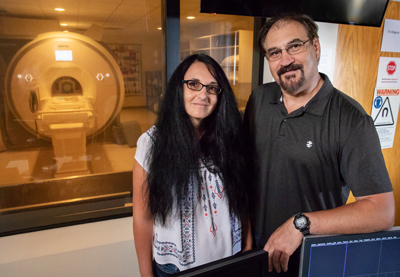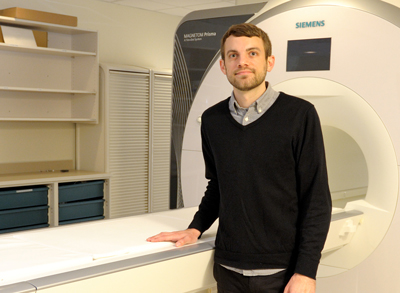Florin and Sanda Dolcos’ connections go way back. Both grew up in the same neighborhood of a Transylvanian city in Romania, went to the University of Bucharest, and studied in the same department. They even have a vivid recollection of being partners in a folk dance as preschool classmates.

Today, that partnership is inspiring research that helps us understand how the emotional aspects of memories impact well-being and what strategies are most effective in facilitating responses to emotions.
“One of our research goals is to provide people in need with a set of effective tools to cope with emotional challenges,” said Florin Dolcos, the leader of the Beckman Institute’s Social and Emotional Dimensions of Well-being Group and an associate professor of psychology.
With an estimated 40 million adults suffering from anxiety and depression in our country, it’s research that holds great promise for improving people’s lives.
“Everyone has unpleasant memories,” said Florin. “When these memories come to mind, it’s difficult for us to focus our attention away from the emotion that the memories elicit. That causes us to be distracted and not able to stay focused on the tasks at hand. For people who struggle with anxiety, depression, or post-traumatic stress disorder, the distraction is so extreme that it impacts their day-to-day lives. Developing strategies to stay focused is certainly important for those people, but it’s really helpful for everyone. We can all benefit from learning ways to control our attention and emotional responses.”
How do you do that? “By not allowing yourself to concentrate on the worst emotions and instead thinking about the context of the same events, like a friend who was there or what the weather was like,” said Florin. “This strategy will take your mind away from the unwanted emotions associated with a negative memory.”
Why Beckman?
“Beckman is in a league of its own in terms of diversity of expertise and opportunities for collaboration. There is a real commitment to push the envelope to stay at the forefront of scientific discovery and a built-in flexibility that allows us to move in a different direction when a new path emerges.”
—Florin and Sanda Dolcos, Social and Emotional Dimensions of Well-being Group
Focused Attention
A recent paper published in Cerebral Cortex explained the research undertaken by the Dolcos Lab, together with Alexandru Iordan, a former Beckman Institute Graduate Fellow who is now a postdoctoral research fellow at the University of Michigan.
The researchers asked participants to complete questionnaires about various events in their lives. Then during a functional MRI (fMRI) scan, they introduced cues to trigger unpleasant autobiographical memories concurrently with a cognitive task. In half of the memories, participants were told to focus on the emotional aspects of the memories. In the others, they were told to focus on the context, details like those Florin suggested: what the weather was like, who they were with, or what time of year it was.
The fMRI results indicated that participants had better cognitive performance when focused on the contextual details rather than the emotional content of their unpleasant memories.
The regions of the brain responsible for processing emotions showed increased activity when participants focused on the emotion of the event, and less activity in regions associated with executive function, such as focused attention. The opposite was true for those who were asked to focus on the context of the event. For them, the areas of the brain associated with emotion and distraction had a reduced response, and the executive function region showed an increased response.
“By training people to use a strategy of focusing on context when distressing memories come to mind, we can help anyone better cope with emotional situations,” said Sanda Dolcos, a research assistant professor of psychology.
This strategy is an alternative to one many people employ when faced with negative memories—suppression, which Sanda said can actually increase anxiety in the long-term.
“By shifting the focus, rather than suppressing the memory, people can actually see the same memory in a new way. With enough practice, the intrusive nature of the distressing memories will be reduced. Plus, it’s a strategy that doesn’t impair cognitive performance, and people can use it any time they need to. It holds promise for helping people with situations in everyday life.”
Understanding Brain Dynamics
Are there personality traits that can protect an individual’s brain against emotional distress? Matt Moore, in collaboration with Florin and Sanda Dolcos, conducted a study of 85 healthy college students to find out.
“In this study, we wanted to look at commonalities across brain regions and across personality traits that contribute as protective factors,” said Moore, a 2018 Beckman Institute Postdoctoral Fellow.

“We targeted a number of regions in the prefrontal cortex, looking specifically at the volume of those regions using structural magnetic resonance imaging. We did a confirmatory factor analysis, which is basically a statistical approach for testing whether there is a common factor underlying the observed measurements.
“We extracted these factors, one at the brain level, one at the personality level, and found that larger volume in this set of brain regions was associated with higher levels of protective personality traits, such as optimism.”
The findings were recently published in Personality Neuroscience, and the next step is to use this information to create ways for individuals to learn how to combat anxiety and depression.
Moore is also working with Florin and Sanda Dolcos, and other Beckman collaborators on advancing the use of simultaneous multimodal brain imaging (fMRI, EEG, and optical imaging) to clarify the spatio-temporal aspects of neural processing associated with cognitive, affective, and social decision-making tasks.
“Using all three modalities provides us with a unique opportunity to understand the dynamics of the brain,” said Moore. “And Beckman is on the forefront of multimodal imaging because we have both the intellectual resources and the state-of-the-art equipment to conduct such collaborative, interdisciplinary, and pioneering work.”

